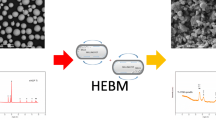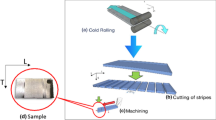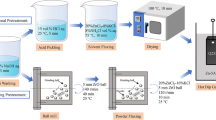Abstract
This paper studies the effect of mechanical activation (MA) modes when stirring a stoichiometric mixture of titanium and soot powders in a ball mill on the properties of mixtures, combustion parameters, relative density, and the microstructure of consolidated titanium carbide samples obtained by SHS. MA conditions for Ti + C reaction mixtures in a ball mill are determined. An increase in the mass of grinding bodies activates the MA mechanism. It is shown that the greatest effect from MA is obtained with a two-stage preparation of mixtures: firstly, the titanium powder is activated separately and then the components are mixed together; this process includes not only their mixing, but also the activation of soot powder. It is found that combustion behavior is affected by the activation of not only titanium, but also soot. After the MA of both components, an anomalous increase in the burning rate (more than 100 cm/s) is found on pressed samples. At the bulk density, there is no effect of MA on the mixture combustion process, since in this case the burning rate of all mixtures is in the range of 1.5–2.5 cm/s. It is revealed that the MA of reagents for pressed samples leads to an increase in the combustion temperature, an increase in the relative density of the consolidated refractory product to 93–95%, and a decrease in the average size of TiC grains. A decrease in the residual porosity of consolidated TiC is due to an increase in the hot-pressing temperature and plasticity of the product synthesized during the reaction mixture combustion after MA. The main reason is an increase in the exothermic interaction rate. It is shown that MA when mixing reagents makes it possible to control combustion parameters and the microstructure of consolidated products and opens up new opportunities for obtaining refractory materials featuring a unique structure and properties by SHS pressing.




Similar content being viewed by others
REFERENCES
Kiparisov, S.S., Levinskii, Yu.V., and Petrov, A.P., Karbid titana. Poluchenie, svoistva, primenenie (Titanium Carbide. Obtaining, Application, Properties), Moscow: Metallurgiya, 1987.
Tret’yakov, V.I., Osnovy metallovedeniya i tekhnologii proizvodstva tverdykh splavov (Fundamentals of Metal Science and Technology for the Production of Hard Alloys), Moscow: Metallurgiya, 1976.
Vasanthakumar, K. and Bakshi, S.R., Effect of C/Ti ratio on densification, microstructure and mechanical properties of TiCx prepared by reactive spark plasma sintering, Ceram. Int., 2018, vol. 44, no. 1, pp. 484–494.
Liu, G., Li, J., and Chen, K., Combustion synthesis of refractory and hard materials: A review, Int. J. Refract. Met. Hard Mater., 2013, vol. 39, pp. 90–102. https://doi.org/10.1016/j.ijrmhm.2012.09.002
Lixia Cheng, Zhipeng Xie, Guanwei Liu, Wei Liu, and Weinjiang Xui, Densification and mechanical properties of TiC by SPS-effects of holding time, sintering temperature and pressure condition, J. Eur. Ceram. Soc., 2012, vol. 32, pp. 3399–3406.
Aziz Babapoo, Mehdi Shahedi Asl, Zohre Ahmadi, and Abbas Sabahi Namini, Effects of spark plasma sintering temperature on densification, hardness and thermal conductivity of titanium carbide, Ceram. Int., 2018, vol. 44, no. 12, pp. 14541–14546. https://doi.org/10.1016/j.ceramint.2018.05.071
Pityulin, A.N., Power compaction in SHS processes, in Samorasprostranyayushchiisya vysokotemperaturnyi sintez: teoriya i praktika (Self-Propagating High-Temperature Synthesis: Theory and Practice), Chernogolovka: Territoriya, 2001, pp. 333–353.
Bogatov, Yu.V., Levashov, E.A., and Pityulin, A.N., The influence of the features of the SHS process on the structure of compact titanium carbide, Poroshk. Metall., 1991, no. 7, pp. 76–78.
Capaldi, M.J., Saidi, A., and Wood, J.V., Reaction synthesis of TiC and Fe–TiC composites, ISIJ Int., 1997, vol. 37, no. 2, pp. 188–193.
Xing-Hong Zhang, Jie-Cai Han, Xiao-Dong He, and Kvanin, V.L., Combustion synthesis and thermal stress analysis of TiC–Ni functionally graded materials, J. Mater. Synth. Process., 2000, vol. 8, no. 1, pp. 29–34.
Xinghong Zhang, Xiaodong He, Jiecai Han, Wei Qu, and Kvanin, V.L., Combustion synthesis and densification of largescale TiC–xNi cermets, Mater. Lett., 2002, vol. 56, no. 3, pp. 183–187.
Shcherbakov, V.A., Telepa, V.T., and Shcherbakov, A.V., Fused TiC by electrothermal explosion under pressure, Int. J. Self-Propag. High-Temp. Synth., 2015, vol. 24, no. 4, pp. 251–252. https://doi.org/10.3103/S1061386215040111
Shcherbakov, V.A., Gryadunov, A.N., Telepa, V.T., and Shcherbakov, A.V., Electrothermal explosion in Ti–C mixtures under pressure., Int. J. Self-Propag. High-Temp. Synth., 2014, vol. 23, no. 2, pp. 122–124.
Alam, M.S. and Shafirovich, E., Mechanically activated combustion synthesis of molybdenum silicides and borosilicides for ultrahigh-temperature structural applications, Proc. Combust. Inst., 2015, vol. 35, pp. 2275–2281. https://doi.org/10.1016/j.proci.2014.05.019
Levashov, E.A., Kurbatkina, V.V., and Kolesnichenko, K.V., Regularities of the effect of preliminary mechanical activation on the reactivity of titanium-based SHS mixtures, Izv. Vyssh. Uchebn. Zaved., Tsvetn. Metall., 2000, no. 6, pp. 61–67.
Maglia, F., Anselmi-Tamburini, U., Deida, C., Delogu, F., Cocco, G., and Munir, Z.F., Role of mechanical activation in SHS synthesis of TiC, J. Mater. Sci., 2004, vol. 39, pp. 5227–5230.
Kochetov, N.A., Rogachev, A.S., and Pogozhev, Yu.S., The effect of mechanical activation of a reaction mixture on the velocity of the wave propagation of SHS reactions and microstructure of the TiC–Ni hard alloy, Russ. J. Non-Ferrous Met., 2010, vol. 51, no. 2, pp. 177–181.
Bogatov, Yu.V., Barinov, V.Yu., and Shcherbakov, V.A., The effect of the morphology of titanium powders on the SHS parameters and the structure of compact titanium diboride, Perspekt. Mater., 2020, no. 3, pp. 50–60. https://doi.org/10.30791/1028-978X-2020-3-50-60
Dymchenko, N.P., Shishlyannikova, L.M., and Yaroslavtseva, N.N., The use of computers for calculating the fine crystalline structure of polycrystals by the second and fourth moments method, Appar. Metody Rentgenovskogo Anal., 1974, no. 15, pp. 37–45.
Saltykov, S.A., Stereometricheskaya metallografiya. Uchebnoe posobie (Stereometric Metallography. Student’s Book), Moscow: Metallurgiya, 1976.
Kiparisov, S.S. and Libenson, G.A., Poroshkovaya metallurgiya (Powder Metallurgy), Moscow: Metallurgiya, 1991.
Shadrinov, N.V. and Kapitonov, E.A., Effect of carbon black activation on the properties of nitrile butadiene rubber, Perspekt. Mater., 2014, no. 8, pp. 50–55.
Rubber Technology. Compounding and Testing for Performance, Dick, J.S., Ed., Munich: Hanser Publ., Cincinnati: Hanser Gardner Publ., 2001.
Ivanovskii, V.I., Tekhnicheskii uglerod. Protsessy i apparaty (Carbon Black. Processes and Apparatuses), Omsk: OAO Tekhuglerod, 2004.
Koval’chenko, M.S., Teoreticheskie osnovy goryachei obrabotki poristykh materialov davleniem (The Theoretical Basis for the Hot Processing of Porous Materials by Pressure), Kiev: Naukova Dumka, 1980.
Author information
Authors and Affiliations
Corresponding authors
Additional information
Translated by A. Muravev
About this article
Cite this article
Bogatov, Y.V., Shcherbakov, V.A. & Kovalev, I.D. Influence of the Mechanical Activation of a Titanium–Carbon Mixture on SHS Pressing Parameters and the Consolidated Titanium Carbide Microstructure. Russ. J. Non-ferrous Metals 62, 585–591 (2021). https://doi.org/10.3103/S1067821221050011
Received:
Revised:
Accepted:
Published:
Issue Date:
DOI: https://doi.org/10.3103/S1067821221050011




